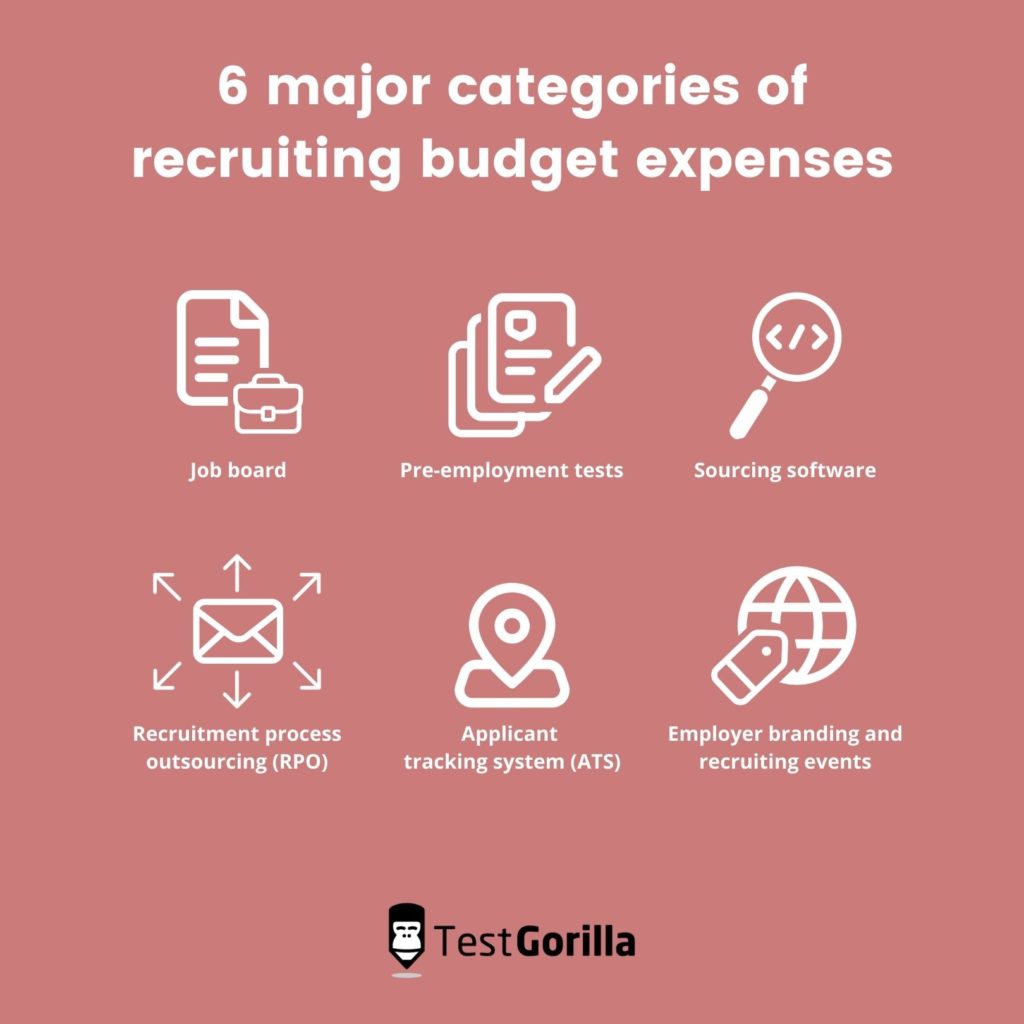Table of contents
As a recruiter, you must have an effective recruitment budget to help the company succeed. However, developing, planning, and implementing a recruiting budget isn’t a simple task.
Every hiring manager needs to avoid many hurdles, challenges, and traps to create an adequate recruiting budget.
Things like recruitment process outsourcing, the cost of recruitment tools such as applicant tracking systems, and recruiting event costs are just some of the challenges in the entire process.
This article will go over six essential elements that will help you develop an effective recruitment budget.
What is a recruiting budget
A recruiting budget is an estimate for the overall annual hiring cost of hiring. It can be divided into two categories: internal and external costs.
Internal costs include hiring managers’ and recruiters’ salaries, whereas external expenses include advertising, sourcing software, and recruitment technology tools. Your recruiting budget should also account for unanticipated expenditure, such as employees leaving the firm.
It’s becoming increasingly common – according to Harvard Business Review, more than 11 million employees will leave their place of employment in a span of three months in 2021, and that’s not all.
According to Gallup, 48% of employees are actively looking for new job opportunities. As a result, you must account for the “unexpected” costs related to employee turnover.
Now that we’ve established what a recruiting budget is let’s look at the responsibilities. Let’s see who’s is in charge of creating, planning, and executing the recruitment strategy and budget.
Who is responsible for a recruiting budget
The size of your organization and the talent management department will influence the creation of your recruiting budget. A recruiting budget is often the result of a collaborative effort by many HR personnel, and having a variety of viewpoints will aid when bargaining with the C-level.
A recruiting manager may create the initial budget, but it must still need to be authorized by higher-ups, such as an HR executive or a CFO. As a result, establishing a substantial recruiting budget with your executives should be a part of your recruitment strategy.
And having your desired budget authorized isn’t easy. SHRM reported that recruiters are expected to hire more people with the same budget year after year. However, there are a few things you may do to get your foot in the door.
Be first. It’s essential to present your recruitment strategy to your C-level as soon as possible. This allows you to negotiate for the things in the plan rather than simply waiting for their response and having little time to make your case. Expect some elements in your strategy to be rejected, but focus on the essential ones and work hard to have those accepted.
Use numbers for claims. Demonstrate to the C-level that you have completed your research and can justify the points in the strategy with facts and figures. This will make you appear prepared, and the executives will be unable to disregard the points from the plan since there will be a reason (and data) behind every item in the recruiting budget.
Attempt to link it with the bottom line. Executives love anything that contributes to the bottom line. So while presenting your recruiting budget, demonstrate how it will help enhance the firm’s bottom line, provide a competitive edge in the market, and offer additional advantages to the organization.
Highlight where you’re saving money. For example, investing in a recruitment budget is a cost-cutting technique, and you should explain to your executives why a large recruitment budget may save them more money than a smaller one.
Identifying the expenses: 6 major categories of a recruiting budget
Negotiating your budget with the higher-ups and figuring out what elements you should invest your funds in are two sides of the same coin. A recruiting budget is divided into six major expenditure areas.
1. Job boards
The costs of job boards are how you will attract prospects to your firm. It’s not enough to post a job on your company website and expect the top candidates to flock to it.
You will need to market your job openings, and job boards are an excellent place to start. It will also be essential to assess the cost of job boards for roles that will need to be filled in your organization due to employee turnover.
2. Pre-employment tests
Every recruitment budget should have funds allocated for pre-employment assessment. These tests play an important role in today’s hiring procedures.
Companies receive hundreds of applications for their applications, and sorting through all the CVs to identify top candidates is problematic. This is where pre-employment tests come into play.
When looking to hire a native Dutch speaker, you can simply administer a brief Dutch language competency exam to all of your applicants and see how they perform. You won’t lose out on the finest applicants this way, and you’ll save time because pre-employment examinations may be administered on a scale.
3. Sourcing software
The use of automated sourcing software will be on a major rise in the upcoming period. With fewer employees available and automation assisting in the recruitment and procurement process, sourcing software will help recruiters locate the best providers.
One thing to keep in mind is to set aside adequate cash for sourcing software and guarantee that you’re getting your money’s worth regarding sourcing software.
4. Recruitment process outsourcing (RPO)
Depending on the size of your firm and HR staff, RPO can play a variety of roles in your organization. Regarding RPO in your recruitment budget, you may choose one of the four options:
End-to-end RPO – the provider manages the whole recruiting process
Project-based RPO – the provider assists you with a specific project, such as the launch of a new branch
Hybrid RPO – where the provider helps with a particular aspect of the recruiting process
Recruiter on demand – the provider sends one or two recruiters to your firm to assist with hiring.
5. Applicant tracking system (ATS)
An applicant tracking system (ATS) is a must-have in today’s hiring process. They help recruiters and hiring managers save time, organize candidate information in one location, and track where each prospect is in the recruiting process.
Applicant tracking systems often have a monthly charge so, it’s good to locate a reliable provider and train your HR team to get used to the ATS.
6. Employer branding and recruiting events
Employer branding includes career fairs, conferences, and recruitment activities. This is where you will promote your organization and find the best new talent.
This category’s expenses include marketing materials, travel costs, overtime and meal expenditures for recruiters, speakers, and so on. Physical events provide a solid first impression on potential candidates, and they are a substantial investment for your recruitment budget.
Tips and tricks on how to create an effective recruiting budget
Follow these recruiting budget best practices:
1. Calculate your cost per hire.
According to SHRM, the average cost of hiring a new employee is over $5,000. Of course, this may vary depending on the industry and company, but when planning your recruiting budget, you must consider the cost per hire in your analysis. Also, attempt to calculate your company’s cost per hire and the annual turnover rate. That will allow you to remain on top of your recruitment expenditures and avoid unpleasant surprises regarding your recruitment budget.
2. Divide costs into fixed, variable, and indirect costs.
Consider past recruiting strategies, plans, and budgets and categorize them into fixed, variable, and indirect costs. This will help you prepare for the coming years and prevent surprises in your recruitment budget.
3. Use spreadsheets and templates.
Many recruiting managers use their recruitment money to try to reinvent the wheel. However, there are several excellent best practices, such as tracking your expenditure with spreadsheets and templates. Make use of them.
4. Calculate DEI recruitment cost into your hiring budget.
One thing to keep in mind is to budget for DEI (Diversity and Inclusion) recruitment costs in your budget. It may take a bit more funds to locate the right person for the job, so make sure you’re prepared for that.
5. Constantly improve your hiring process effectiveness.
New technology, sourcing tools, software, ATS, or simply bringing in new people to work can enhance every recruiting process. Allocate some funds in your recruiting budget to improve your hiring process — it will save you time and money in the long run.
Stay within your recruiting budget and still hire the best candidates
Remember the six major areas of costs when creating a recruiting budget, and utilize spreadsheets and templates to manage your spending.
Pre-employment assessments are also an excellent case practice for a successful recruiting budget. Whether you’re looking for a JavaScript developer or a business teacher, you should use pre-employment tests to verify the abilities they claim to possess in their resumes.
TestGorilla’s Test Library contains over 170 pre-employment skills tests. So, evaluate your existing recruiting procedure, identify the relevant test, and administer it to your applicants to determine who will perform the best.
Get started today for free, and start making better hiring decisions, faster and bias-free.
Related posts
Hire the best candidates with TestGorilla
Create pre-employment assessments in minutes to screen candidates, save time, and hire the best talent.
Latest posts
The best advice in pre-employment testing, in your inbox.
No spam. Unsubscribe at any time.

Hire the best. No bias. No stress.
Our screening tests identify the best candidates and make your hiring decisions faster, easier, and bias-free.
Free resources
This checklist covers key features you should look for when choosing a skills testing platform
This resource will help you develop an onboarding checklist for new hires.
How to assess your candidates' attention to detail.
Learn how to get human resources certified through HRCI or SHRM.
Learn how you can improve the level of talent at your company.
Learn how CapitalT reduced hiring bias with online skills assessments.
Learn how to make the resume process more efficient and more effective.
Improve your hiring strategy with these 7 critical recruitment metrics.
Learn how Sukhi decreased time spent reviewing resumes by 83%!
Hire more efficiently with these hacks that 99% of recruiters aren't using.
Make a business case for diversity and inclusion initiatives with this data.




















